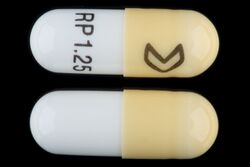Chemistry:Ramipril
 | |
| Clinical data | |
|---|---|
| Trade names | Altace, others |
| AHFS/Drugs.com | Monograph |
| MedlinePlus | a692027 |
| License data | |
| Routes of administration | By mouth |
| ATC code | |
| Legal status | |
| Legal status | |
| Pharmacokinetic data | |
| Bioavailability | 28% |
| Protein binding | 73% (ramipril) 56% (ramiprilat) |
| Metabolism | Liver, to ramiprilat |
| Elimination half-life | 13 to 17 hours |
| Excretion | Kidney (60%) and fecal (40%) |
| Identifiers | |
| |
| CAS Number | |
| PubChem CID | |
| IUPHAR/BPS | |
| DrugBank | |
| ChemSpider | |
| UNII | |
| KEGG | |
| ChEBI | |
| ChEMBL | |
| Chemical and physical data | |
| Formula | C23H32N2O5 |
| Molar mass | 416.518 g·mol−1 |
| 3D model (JSmol) | |
| Melting point | 109 °C (228 °F) |
| |
| |
| (verify) | |
Ramipril, sold under the brand name Altace among others, is an ACE inhibitor type medication used to treat high blood pressure, heart failure, and diabetic kidney disease.[1] It can also be used as a preventative medication in patients over 55 years old to reduce the risk of having a heart attack, stroke or cardiovascular death in patients shown to be at high risk, such as some diabetics and patients with vascular disease.[2][3][4] It is a reasonable initial treatment for high blood pressure.[1] It is taken by mouth.[1]
Common side effects include headaches, dizziness, feeling tired, and cough.[1] Serious side effects may include liver problems, angioedema, kidney problems, and high blood potassium.[1] Use in pregnancy and breastfeeding is not recommended.[5] It is an ACE inhibitor and works by decreasing renin-angiotensin-aldosterone system activity.[1]
Ramipril was patented in 1981 and approved for medical use in 1989.[6] It is available as a generic medication.[7] In 2020, it was the 196th most commonly prescribed medication in the United States, with more than 2 million prescriptions.[8][9]
Activation and binding
Ramipril is a pro-drug. The molecule must be hydrolyzed by the esterase at the OCH2CH3 and form a carboxylate. This carboxylate then interacts with the positive Zn+2 to inhibit the ACE enzyme. The COOH helps orient it with the enzyme. Ramipril is similar in structure to another ACE Inhibitor, trandolapril, but it has a second cyclopentane ring instead of a cyclohexane ring.
Medical uses
Medical uses include:
- High blood pressure
- Congestive heart failure[10]
- Following heart attack in people with evidence of heart failure
- People over 55 years at high risk: prevention of heart attack, stroke, cardiovascular death, or in need of revascularization procedures
- Prevent the onset and/or delay the progression of diabetic kidney disease, with or without proteinuria.[11] Randomized trial evidence suggests that a maximum tolerable dose prevents cardiovascular events and death in patients with diabetic kidney disease.
Contraindications
Contraindications to its use include volume-depleted patients, a history of angioedema while on an ACE inhibitor, pregnancy and hypotension.[citation needed]
People should not take ramipril (or any ACE inhibitors) if they have hyperkalemia. It is also recommended to avoid using salt-substitutes as this can further increase potassium levels in the blood.[1]
Ramipril can be considered in patients with bilateral or unilateral significant renal artery stenosis (RAS).[12] An early rise in serum creatinine above baseline is expected after initiation of therapy with Ramipril, however, monitoring serum biochemistry and renal function after initiation is crucial.[12][13] Treatment with Ramipril in some patients with significant narrowing in both kidneys can increase serum creatinine concentration (measured in the blood test), which returns to baseline upon therapy cessation.[14]
Adverse effects
- Shakiness
- Dry cough
- Dizziness and light-headedness due to low blood pressure
- Fatigue, especially in the early stages
- Mouth dryness in the early stages
- Nausea
- Fainting
- Signs of infection (e.g., fever, chills, persistent sore throat)
- Chest pain
- Neutropenia (low white blood cells)
- Impotence (erectile dysfunction)[15]
- Hyperkalemia
Serious allergic reactions to this drug are unlikely, but immediate medical attention must be sought if they occur. Symptoms of a serious allergic reaction include, but are not limited to a rash or swelling of the face, mouth, tongue, or throat. In extreme cases, ramipril may lead to potentially fatal liver problems.
Mechanism of action
ACE inhibitors inhibit the actions of angiotensin converting enzyme (ACE), thereby lowering the production of angiotensin II and decreasing the breakdown of bradykinin. The decrease in angiotensin II results in relaxation of arteriole smooth muscle leading to a decrease in total peripheral resistance, reducing blood pressure as the blood is pumped through widened vessels. Its effect on bradykinin is responsible for the dry cough side effect.
Ramipril, a prodrug or precursor drug, is converted to the active metabolite ramiprilat by carboxylesterase 1.[16][17] Ramiprilat is mostly excreted by the kidneys. Its half-life is variable (3–16 hours), and is prolonged by heart and liver failure, as well as kidney failure. Peak effect occurs between 3 and 6 hours after dosing, with approximately 50% of this effect retained after 24 hours.[18]
Society and culture
US patent
The compound was protected by a patent which was assigned to the German pharmaceutical company Hoechst AG (since merged into Aventis) on 29 October 1991.[19] The patent was scheduled to expire on 29 October 2008. On 11 September 2007, in an appeal by the Indian company Lupin Ltd., the United States Court of Appeals for the Federal Circuit reversed a district court trial verdict and found that Aventis's patent on ramipril was invalid for "obviousness", opening this drug to generic manufacturers.
Brand names
Ramipril is marketed as Prilace by Arrow Pharmaceuticals in Australia, Ramipro by Westfield Pharma in the Philippines, Triatec by Sanofi-Aventis in Italy and United States and Altace by King Pharmaceuticals in the United States, Novapril by Pharmanova in Ghana, Ramitens by PharmaSwiss, Ampril by Krka in Slovenia, Corpril by Cemelog-BRS in Hungary, Piramil and Prilinda by Hemofarm in Serbia, by Lek in Poland and by Novartis and Opsonin Pharma Limited as Ramace in Bangladesh, and in Canada as Altace (Sonfi) and Ramipril (Pharmascience).
Ramipril is marketed in India under the brand names Cardace, Zigpril, Ramistar, Odipril and Zorem . Ramipril is marketed in Myanmar under brand name Endpril .
Research
The 2001 Heart Outcomes and Prevention Evaluation trial seemed to show ramipril possessed cardioprotective qualities which extended beyond its qualities as an antihypertensive.[20][21] However, the trial and the interpretation of its results have been criticised.[22]
The Acute Infarction Ramipril Efficacy (AIRE) trial[16][23] showed a 27% reduction in mortality for patients receiving ramipril for chronic heart failure following a myocardial infarction.
Ramipril was found to have similar results as telmisartan, an angiotensin II receptor blocker.[24]
References
- ↑ Jump up to: 1.0 1.1 1.2 1.3 1.4 1.5 1.6 "Ramipril Monograph for Professionals" (in en). American Society of Health-System Pharmacists. https://www.drugs.com/monograph/ramipril.html.
- ↑ "Effects of an angiotensin-converting-enzyme inhibitor, ramipril, on cardiovascular events in high-risk patients". The New England Journal of Medicine 342 (3): 145–53. January 2000. doi:10.1056/NEJM200001203420301. PMID 10639539.
- ↑ HOPE study investigators (January 2000). "Effects of ramipril on cardiovascular and microvascular outcomes in people with diabetes mellitus: results of the HOPE study and MICRO-HOPE substudy" (in en). The Lancet 355 (9200): 253–259. doi:10.1016/S0140-6736(99)12323-7. https://linkinghub.elsevier.com/retrieve/pii/S0140673699123237.
- ↑ "A meta-analysis reporting effects of angiotensin-converting enzyme inhibitors and angiotensin receptor blockers in patients without heart failure". Journal of the American College of Cardiology 61 (2): 131–42. January 2013. doi:10.1016/j.jacc.2012.10.011. PMID 23219304.
- ↑ "Ramipril Pregnancy and Breastfeeding Warnings" (in en). https://www.drugs.com/pregnancy/ramipril.html.
- ↑ (in en) Analogue-based Drug Discovery. John Wiley & Sons. 2006. p. 469. ISBN 9783527607495. https://books.google.com/books?id=FjKfqkaKkAAC&pg=PA469.
- ↑ British national formulary : BNF 76 (76 ed.). Pharmaceutical Press. 2018. pp. 172–173. ISBN 9780857113382.
- ↑ "The Top 300 of 2020". https://clincalc.com/DrugStats/Top300Drugs.aspx.
- ↑ "Ramipril - Drug Usage Statistics". https://clincalc.com/DrugStats/Drugs/Ramipril.
- ↑ "Effect of different angiotensin-converting-enzyme inhibitors on mortality among elderly patients with congestive heart failure". CMAJ 178 (10): 1303–11. May 2008. doi:10.1503/cmaj.060068. PMID 18458262.
- ↑ "Prevention and treatment of diabetic renal disease in type 2 diabetes: the BENEDICT study". Journal of the American Society of Nephrology 17 (4 Suppl 2): S90-7. April 2006. doi:10.1681/ASN.2005121324. PMID 16565256.
- ↑ Jump up to: 12.0 12.1 "Dispelling the myth: the use of renin-angiotensin blockade in atheromatous renovascular disease". Nephrology, Dialysis, Transplantation 27 (4): 1403–1409. April 2012. doi:10.1093/ndt/gfr496. PMID 21993376.
- ↑ "Use of angiotensin-converting enzyme inhibitors in patients with heart failure and renal insufficiency: how concerned should we be by the rise in serum creatinine?". Journal of the American Geriatrics Society 50 (7): 1297–1300. July 2002. doi:10.1046/j.1532-5415.2002.50321.x. PMID 12133029.
- ↑ "Dispelling the myth: the use of renin-angiotensin blockade in atheromatous renovascular disease". Nephrology, Dialysis, Transplantation 27 (4): 1403–1409. April 2012. doi:10.1093/ndt/gfr496. PMID 21993376.
- ↑ "Ramipril Side Effects". http://heart-disease.emedtv.com/ramipril/ramipril-side-effects.html.
- ↑ Jump up to: 16.0 16.1 "Ramipril. An updated review of its therapeutic use in essential hypertension and heart failure". Drugs 49 (3): 440–466. March 1995. doi:10.2165/00003495-199549030-00008. PMID 7774515.
- ↑ "In vitro drug metabolism by human carboxylesterase 1: focus on angiotensin-converting enzyme inhibitors". Drug Metabolism and Disposition 42 (1): 126–133. January 2014. doi:10.1124/dmd.113.053512. PMID 24141856.
- ↑ "24-hour blood pressure profiles in hypertensive patients administered ramipril or placebo once daily: magnitude and duration of antihypertensive effects.". Clinical Cardiology (Wiley) 14 (9): 737–742. September 1991. doi:10.1002/clc.4960140908. PMID 1835914.
- ↑ U.S. Patent 5,061,722
- ↑ "HOPE Trial: Main Outcomes and Serum Creatinine". Hypertension Online. 13 August 2001. http://www.hypertensiononline.org/slides2/slide01.cfm?q=ramipril&dpg=10. "Ramipril significantly reduced the high cardiovascular risk associated with renal insufficiency"
- ↑ "Ramipril reduced mortality and cardiovascular morbidity in high risk adults". BMJ Evidence-Based Medicine (BMJ Publishing Group Ltd) 5 (2): 47. March 2000. doi:10.1136/ebm.5.2.47.
- ↑ "Debate: Do ACE Inhibitors Have Unique Properties, Beyond Their Antihypertensive Effect?". MedScape. 2002. http://www.medscape.com/viewarticle/430926.
- ↑ "Effect of ramipril on mortality and morbidity of survivors of acute myocardial infarction with clinical evidence of heart failure. The Acute Infarction Ramipril Efficacy (AIRE) Study Investigators". Lancet 342 (8875): 821–8. October 1993. doi:10.1016/0140-6736(93)92693-N. PMID 8104270.
- ↑ "Telmisartan, ramipril, or both in patients at high risk for vascular events". The New England Journal of Medicine 358 (15): 1547–59. April 2008. doi:10.1056/NEJMoa0801317. PMID 18378520.
External links
- "Ramipril". Drug Information Portal. U.S. National Library of Medicine. https://druginfo.nlm.nih.gov/drugportal/name/Ramipril.
 |


